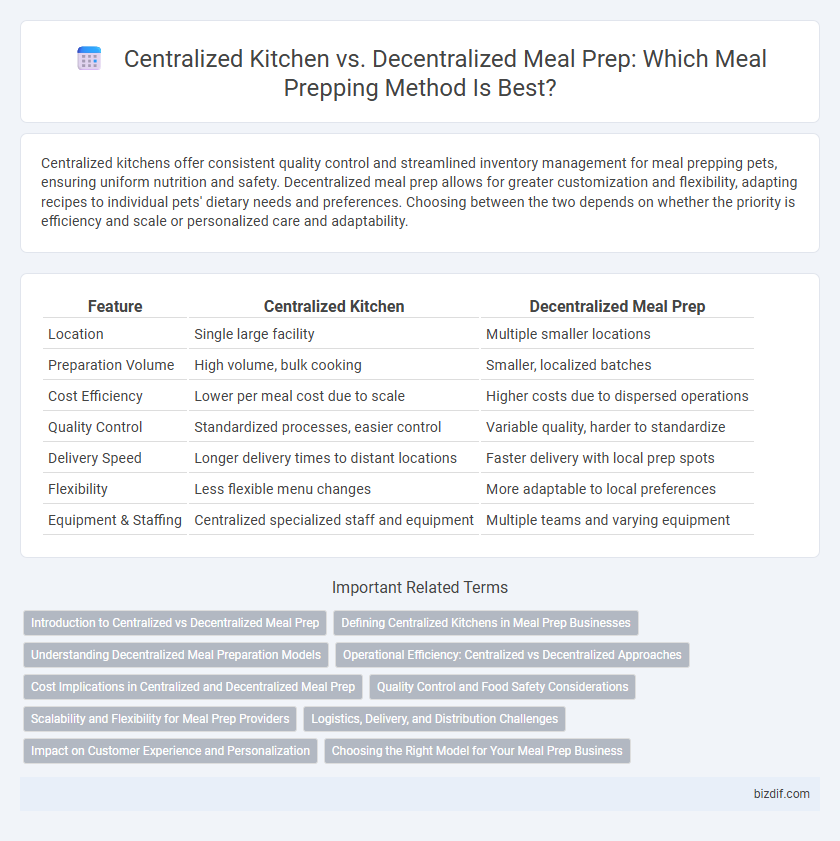Centralized kitchens offer consistent quality control and streamlined inventory management for meal prepping pets, ensuring uniform nutrition and safety. Decentralized meal prep allows for greater customization and flexibility, adapting recipes to individual pets' dietary needs and preferences. Choosing between the two depends on whether the priority is efficiency and scale or personalized care and adaptability.
Table of Comparison
| Feature | Centralized Kitchen | Decentralized Meal Prep |
|---|---|---|
| Location | Single large facility | Multiple smaller locations |
| Preparation Volume | High volume, bulk cooking | Smaller, localized batches |
| Cost Efficiency | Lower per meal cost due to scale | Higher costs due to dispersed operations |
| Quality Control | Standardized processes, easier control | Variable quality, harder to standardize |
| Delivery Speed | Longer delivery times to distant locations | Faster delivery with local prep spots |
| Flexibility | Less flexible menu changes | More adaptable to local preferences |
| Equipment & Staffing | Centralized specialized staff and equipment | Multiple teams and varying equipment |
Introduction to Centralized vs Decentralized Meal Prep
Centralized kitchens streamline meal prepping by preparing large batches of food in a single, controlled location, enhancing consistency and reducing costs through bulk purchasing. Decentralized meal prep distributes cooking tasks across multiple smaller kitchens or home environments, allowing for customization and flexibility to meet diverse dietary needs. Selecting between centralized and decentralized systems depends on factors like scale, budget, menu complexity, and distribution logistics.
Defining Centralized Kitchens in Meal Prep Businesses
Centralized kitchens in meal prep businesses serve as a designated facility where meals are prepared, cooked, and packaged in bulk before distribution to multiple locations or customers. This approach streamlines operations by consolidating kitchen resources, reducing overhead costs, and ensuring consistent quality control across all meal offerings. Centralized kitchens support scalability and efficiency, making them ideal for businesses aiming to deliver large volumes of standardized meal plans.
Understanding Decentralized Meal Preparation Models
Decentralized meal preparation models distribute cooking tasks across multiple locations, enabling personalized menu options and reducing transportation time compared to centralized kitchens. This approach enhances flexibility for dietary accommodations and local sourcing, increasing freshness and customer satisfaction. Decentralized models leverage technology for coordination and quality control, improving operational efficiency and scalability in meal prep services.
Operational Efficiency: Centralized vs Decentralized Approaches
Centralized kitchens streamline meal prepping by consolidating resources, reducing redundant tasks, and enabling bulk purchasing, which significantly lowers operational costs. Decentralized meal prep offers flexibility and faster response to local demand fluctuations but often incurs higher logistics expenses and challenges in maintaining consistent quality standards. Balancing centralized control with decentralized execution can optimize operational efficiency in meal prep services.
Cost Implications in Centralized and Decentralized Meal Prep
Centralized kitchens reduce overall costs through bulk purchasing, streamlined labor, and minimized kitchen equipment, making them highly cost-effective for large-scale meal prep operations. Decentralized meal prep incurs higher expenses due to duplicated overheads, increased labor costs, and less efficient supply management across multiple locations. Analyzing cost implications reveals centralized setups optimize resource allocation, while decentralized models offer flexibility at a premium price point.
Quality Control and Food Safety Considerations
Centralized kitchens enable stringent quality control and consistent food safety standards through standardized processes, regulated environments, and dedicated hygiene protocols, reducing contamination risks. Decentralized meal prep offers flexibility and quicker turnaround times but may face challenges in maintaining uniform quality and consistent food safety practices due to varied locations and personnel. Ensuring comprehensive training and regular inspections are critical to uphold safety and quality across decentralized meal prep operations.
Scalability and Flexibility for Meal Prep Providers
Centralized kitchens enable meal prep providers to achieve high scalability by consolidating operations, streamlining ingredient sourcing, and standardizing cooking processes, which reduces overhead costs and facilitates consistent quality control. Decentralized meal prep models offer greater flexibility, allowing providers to cater to localized tastes, adjust menus quickly, and reduce delivery times by operating closer to the end consumer. Balancing scalability with flexibility depends on provider goals, with centralized systems excelling in volume production and decentralized approaches enhancing customization and rapid market response.
Logistics, Delivery, and Distribution Challenges
Centralized kitchen models streamline meal preparation by consolidating cooking and packaging processes in one location, reducing operational costs but increasing logistical complexity in delivery routes and timing. Decentralized meal prep spreads production across multiple smaller kitchens closer to customers, minimizing delivery distances and improving freshness while posing challenges in maintaining consistent quality and coordinating distributed inventory. Efficient distribution in centralized systems relies heavily on robust route planning and cold chain management, whereas decentralized setups require strong communication protocols and technology for synchronized inventory and demand forecasting.
Impact on Customer Experience and Personalization
Centralized kitchens streamline meal prep by ensuring consistent quality and efficient resource management, enhancing overall customer satisfaction through reliable delivery times and standardized portion control. Decentralized meal prep offers greater personalization by allowing for customization of meals closer to the customer, increasing the ability to meet dietary preferences and fresh ingredient demands. The choice between centralized and decentralized models directly affects customer experience, balancing uniformity and efficiency with flexibility and tailored meal options.
Choosing the Right Model for Your Meal Prep Business
Choosing the right model for your meal prep business hinges on factors such as scale, target market, and operational efficiency. Centralized kitchens streamline production, reduce costs, and ensure consistent quality, making them ideal for larger businesses with high-volume orders. Decentralized meal prep offers flexibility and localized customization, suited for smaller operators aiming to serve diverse communities with tailored menus.
Centralized Kitchen vs Decentralized Meal Prep Infographic

 bizdif.com
bizdif.com